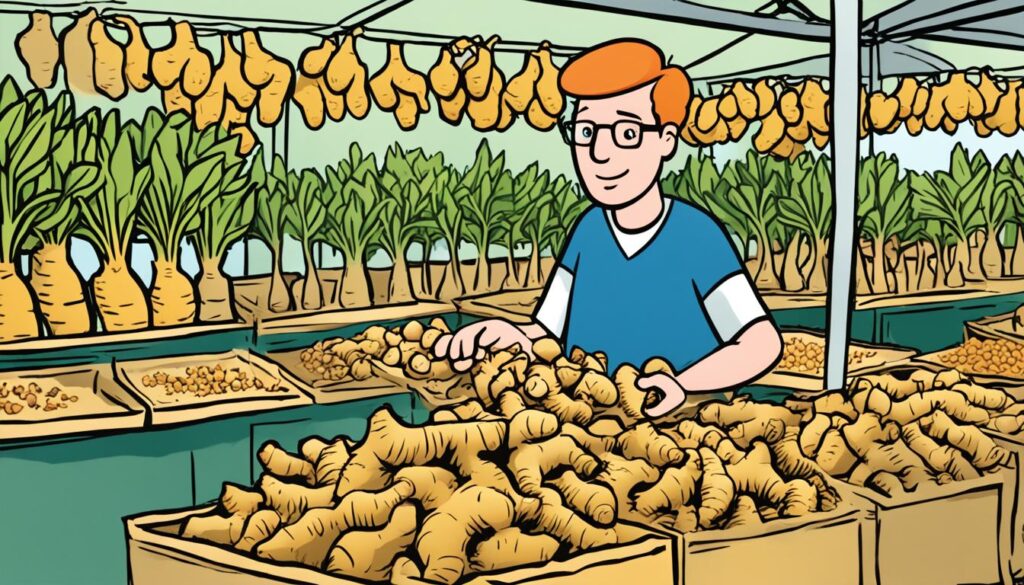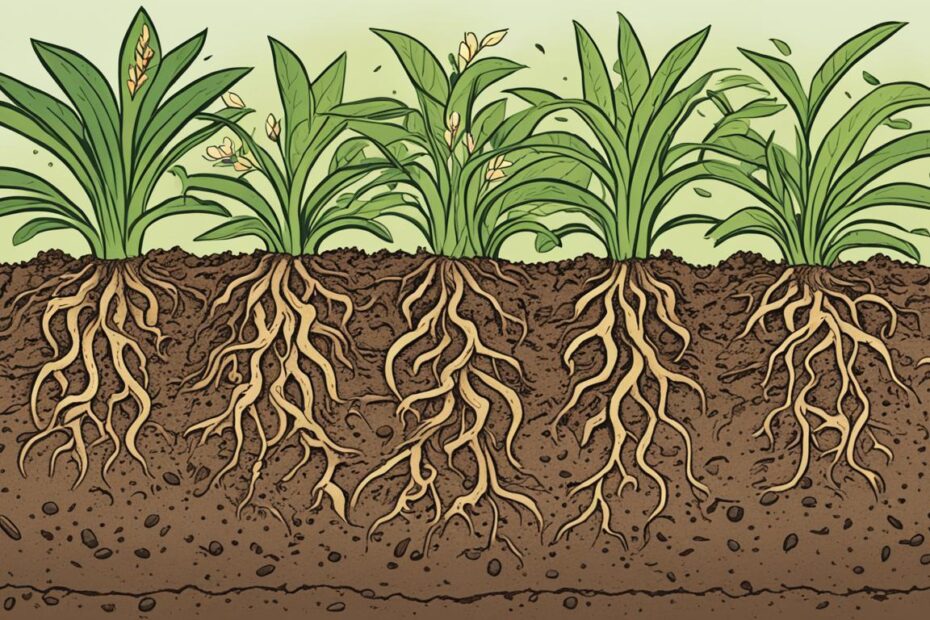Are you getting the best out of your ginger plants? Have you ever wondered what makes some ginger plants flourish while others struggle to grow? The secret lies in the soil. Discover the key to successful ginger gardening by understanding the best soil requirements for this tropical herb.
Ginger, a tropical perennial herb, requires specific soil conditions to thrive and produce bountiful harvests. By providing the optimal soil environment, you can cultivate ginger plants that are vibrant, healthy, and full of flavor. So, what exactly is the best soil for ginger?
Key Takeaways:
- The best soil for ginger is rich in organic matter and well-draining.
- The soil should have a pH level between 5.5 and 6.5.
- Loose and loamy soil allows ginger rhizomes to grow and spread.
- Adding compost or straw can provide nutrients and retain water.
- Fertile soil with organic fertilizers promotes healthy growth.
Understanding How Ginger Grows
Ginger, with its unique flavor and versatility, is a herb that captivates gardeners and chefs alike. To successfully grow ginger, it’s essential to understand its growth process and the key elements that contribute to its development. Let’s take a closer look at how ginger grows, from its underground rhizomes to the emergence of vibrant shoots.
Ginger is propagated from rhizomes, which are fleshy stems that spread horizontally beneath the soil’s surface. These rhizomes contain multiple growing points, allowing them to sprout and develop into new plants. When planting ginger, these rhizomes are buried below ground, resulting in the growth of bamboo-like shoots.
As the weather warms up in spring, ginger shoots begin to emerge from the soil’s surface. These shoots serve as the source of energy for the developing ginger beneath the ground. With the arrival of long, warm summer days, the ginger plant flourishes, basking in the sunlight and absorbing nutrients from the soil.
However, as the days grow shorter and cooler, the ginger’s growth cycle is influenced, signaling the plant’s dormancy period. During this time, the leaves of the ginger plant turn yellow, indicating the plant’s readiness for dormant phase. While the foliage may wither, the energy gathered during the active growing period is stored in the ginger rhizomes, ensuring the plant’s survival and future growth.
Understanding how ginger grows is crucial for cultivating it successfully. By harnessing the knowledge of its growth cycle, gardeners can provide the optimal conditions that ginger plants thrive in. From the planting of rhizomes to the emergence of shoots and the plant’s transition into dormancy, each stage is integral to ginger’s development.
Purchasing and Preparing Ginger for Planting
When it comes to cultivating ginger in your garden, selecting and preparing the right ginger rhizomes is key to ensure successful growth and development. Follow these steps to buy and prepare ginger rhizomes for planting:
1. Selecting High-Quality Ginger Rhizomes
When purchasing ginger rhizomes, opt for high-quality and organic options. Look for ginger with the following characteristics:
- Light-Colored, Thin Skin: Choose ginger with light-colored and thin skin, as it indicates freshness and maturity.
- Multiple Bumpy Nodules: Look for ginger rhizomes that have several bumpy nodules, as these nodules are key for ginger growth.
You can buy ginger rhizomes from reputable seed companies online or source them from your local market. Ensure that you get fresh and healthy ginger rhizomes for the best results.
2. Preparing Ginger Rhizomes for Planting
Before planting ginger rhizomes, it’s important to prepare them properly:
- Cutting into Pieces: Cut the ginger rhizomes into pieces that are approximately 2″-3″ in length.
- Nodule Count: Ensure that each ginger rhizome piece has at least 2-3 nodules.
By cutting the rhizomes into smaller pieces, you create more planting opportunities and increase the chances of successful growth. The nodules on the ginger rhizomes will serve as the starting point for new shoots and roots.

“Proper selection and preparation of ginger rhizomes are crucial to ensure successful growth and development.”
After cutting the ginger rhizomes, it’s important to let the cut ends dry and heal over. This process helps prevent rotting and allows the rhizomes to establish a protective layer. Once the cut ends have dried, the ginger rhizomes are ready for planting.
When preparing ginger rhizomes, take your time and handle them with care. This step is essential for the healthy development of your ginger plants.
Ginger Rhizome Selection Checklist
| Characteristics | What to Look For |
|---|---|
| Color and Texture | Light-colored and thin skin |
| Nodule Count | At least 2-3 bumpy nodules |
Ensure that the ginger rhizomes you select meet the criteria listed in the table above. This checklist serves as a guide to help you choose the best ginger rhizomes for optimal growth outcomes.
Planting and Caring for Ginger
Ginger is a resilient plant that requires proper planting and care to ensure optimal growth and a bountiful harvest. Whether you’re growing ginger outdoors or in containers, follow these essential tips for successful cultivation.
Planting Ginger
If you live in a warmer climate, you can directly plant ginger outdoors after the last frost date. Wait until the soil has warmed up in spring, as ginger thrives in a long, warm growing season of about 10 months. Plant the ginger rhizomes 2 inches deep and space them 6-8 inches apart, with the growing nodules facing up.
In cooler climates, pre-sprouting the ginger rhizomes indoors before planting is necessary. This process involves placing the rhizomes in a warm, moist environment to encourage the growth of shoots. Once the shoots have emerged, transfer the sprouted rhizomes to the soil, following the same planting depth and spacing guidelines.
Remember to provide adequate water for newly planted ginger to establish in the soil. Water consistently, especially during the active growing period, but be cautious not to overwater, as ginger prefers moist soil rather than soggy conditions.
If you’re considering container gardening for ginger, choose a large pot with good drainage. Place the rhizomes in the pot, ensuring they are covered with 2 inches of soil. Keep the container in a warm and sunny location, watering it regularly to maintain appropriate moisture levels.
Ginger Care Tips
- Regularly water ginger plants to keep the soil consistently moist. Aim for a balance, avoiding overwatering that can lead to root rot.
- Fertilize ginger plants every 4-6 weeks with organic fertilizers such as liquid seaweed or fish emulsion. These will provide the necessary nutrients for healthy growth.
- Provide shade for ginger plants in hot summer locations to protect them from intense sunlight. This can help prevent sunburn and maintain optimal growing conditions.
- Monitor the leaves of ginger plants for any signs of pests or diseases. Treat any issues promptly to ensure the health and vitality of your plants.
- Harvest ginger in autumn when the leaves begin to yellow, and the rhizomes have reached maturity. Gently dig around the base of the plant to avoid damaging the rhizomes.
By following these planting and care tips, you can enjoy a flourishing ginger garden and savor the rewards of your hard work. Whether you choose to grow ginger outdoors or in containers, providing the right conditions and attentive care will yield a flavorful and aromatic harvest.

Conclusion
Growing ginger can be a truly fulfilling endeavor for gardeners, offering not only a versatile herb with a unique flavor and aroma but also the satisfaction of nurturing and harvesting your own crop. To ensure successful ginger cultivation, it is essential to select the best soil for ginger gardening and understand the specific requirements of this tropical perennial herb.
By providing the right growing conditions, such as loose and loamy soil rich in organic matter with a pH level between 5.5 and 6.5, gardeners can create an ideal environment for ginger to thrive. Regular watering, taking care not to overwater, and utilizing organic fertilizers like liquid seaweed or fish emulsion can promote healthy growth throughout the long, warm growing season.
Whether you choose to grow ginger in your garden or in containers, employing proper preparation techniques, planting at the right depth, and spacing the rhizomes properly are key to achieving a bountiful harvest. Be sure to keep an eye on the foliage, as the leaves turning yellow signals the approaching time for ginger harvest. Once harvested, the ginger roots can add a burst of flavor to a variety of culinary delights.
Incorporate these ginger care tips into your gardening routine, and you’ll be rewarded with homegrown ginger that surpasses anything you can find in stores. Savor the vibrant taste and aroma of freshly harvested ginger, and enjoy the satisfaction of creating something marvelous from your own efforts. Cultivate success in your ginger gardening journey and let this tropical herb flourish in your care.
FAQ
What is the best soil for ginger gardening?
The best soil for ginger is rich in organic matter, well-draining, and has a pH level between 5.5 and 6.5. It should be loose and loamy, allowing the ginger rhizomes to grow and spread. Adding compost or straw to the soil can provide nutrients, control weeds, and retain water.
How do ginger plants grow?
Ginger is grown from rhizomes, which are fleshy stems that spread horizontally underground and contain multiple growing points. The rhizomes are planted below ground and produce bamboo-like shoots that supply energy to the developing ginger beneath the surface.
Where can I purchase ginger rhizomes for planting?
Ginger rhizomes can be purchased from seed companies online or sourced from the local market. When buying ginger rhizomes, look for high-quality, organic ginger with light-colored, thin skin and several bumpy nodules.
How should I prepare ginger rhizomes for planting?
Before planting, ginger rhizomes should be cut into 2″-3″ pieces, ensuring that each piece has at least 2-3 nodules. The cut ends of the rhizomes should be allowed to dry and heal over before planting.
When and how should I plant ginger?
In warmer climates, ginger can be planted directly outdoors after the last frost date and when the soil has warmed up in spring. Rhizomes should be planted 2″ deep and 6″-8″ apart, with the growing nodules facing up. In cooler climates, pre-sprouting rhizomes indoors before planting is necessary.
How do I care for ginger plants?
Ginger plants should be watered regularly, especially during the active growing period, while avoiding overwatering. Fertilizing with organic fertilizers like liquid seaweed or fish emulsion can promote healthy growth. Providing shade in hot summer locations can protect the ginger plants from intense sunlight.
